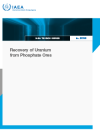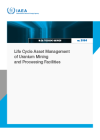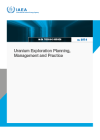Uranium is the primary fuel for nuclear reactors and must be managed properly, in a safe and sustainable manner. Recent annual production of natural uranium world-wide has been between 55,000 and 65,000 tons of uranium metal, similar to the fuel demand. Additionally, thorium is also being investigated as a potential alternate source of nuclear fuel.
Uranium production
Managing the uranium production cycle in a responsible manner involves a number of aspects: the exploration for, discovery of and assessment of resources; mining and processing; technology selection and testing; prefeasibility and feasibility studies; construction and operation of mining and processing facilities; and, finally, the appropriate closure of a uranium production sites where the resource has been depleted. All stages of this cycle must be based on best practices and aim for a minimal adverse impact on environment and society and bring benefits to local and national societies and economies.
The IAEA supports its Member States in all aspects of the Uranium Production Cycle by the provision of uranium deposit databases and publications, by organizing, through the Department of Nuclear Energy’s own resources and through the IAEA Department of Technical Cooperation for eligible Member States, technical meetings and workshops, and by offering technical advice on various aspects of the Uranium Production Cycle.
Specifically, the IAEA disseminates up-to-date information on the status of the world’s uranium resources and its production. Through the World Distribution of Uranium Deposits (UDEPO) database and its publications, such as the World Distribution of Uranium Deposits and other associated documents, along with the Red Book on uranium resources, production and demand, the Agency reports on uranium deposits around the world, classifying deposits and providing technical as well as geological information about them. It prepares projections of uranium requirements and distributes information on uranium exploration and responsible mining and milling, covering not only uranium deposits but also mineral deposits that yield uranium as a secondary product.
The IAEA also assists Member States that are exploring for uranium resources or are seeking to develop identified resources. While these Member States may not yet have the adequate technological infrastructure and suitably trained human resources, the Agency can help facilitate training and knowledge development and help them apply the best practices available that are appropriate to their individual circumstances.
Furthermore, review services are available on request, notably through the Uranium Production Site Appraisal Team (UPSAT) review missions. This is a service for promotion of best practices and safety in the uranium production cycle, which is customized to an individual Members State’s requirements.
Some Member States are particularly interested in the thorium fuel cycle as a sustainable means for growing the use of nuclear energy. Major incentives for this are the natural abundance of thorium; its inert nature and better thermo-physical properties compared to uranium; a high burnup capability; its suitability for high conversion ratio fuel cycles; and its inherent proliferation resistance characteristics. Research and development is moving in some countries towards the future use of thorium as a supplement to or potential replacement of uranium as a primary fuel source.








